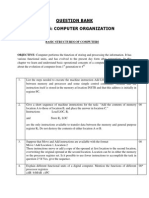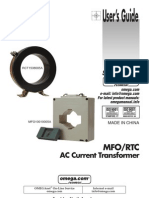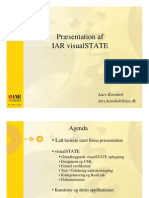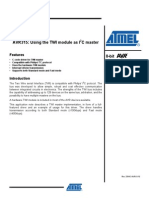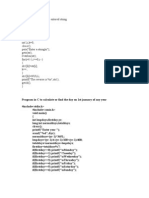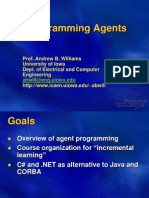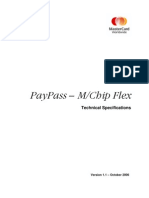Mips Reference
Mips Reference
Uploaded by
thắngCopyright:
Available Formats
Mips Reference
Mips Reference
Uploaded by
thắngCopyright
Available Formats
Share this document
Did you find this document useful?
Is this content inappropriate?
Copyright:
Available Formats
Mips Reference
Mips Reference
Uploaded by
thắngCopyright:
Available Formats
CS141
MIPS Architecture Reference
MIPS Architecture Reference - Edited for CS 141
Lukasz Strozek
December 9, 2005 Based on Hennessy and Pattersons Computer Organization and Design
Introduction to MIPS
MIPS is a RISC-like architecture (but MIPS is also the name of a microprocessor implementing that architecture): that is, its instructions are simple and execute fast, yet the architecture is immensely powerful. In the nal three weeks of the semester you will implement a fully functional MIPS datapath. Your datapath will implement most of the instructions from the original MIPS R2000. We will skip oating point instructions, most of the system calls and simplify exception handling, but beyond that were implementing full MIPS. At rst glance, MIPS may seem simplistic, but its a very powerful architecture. If you take CS 161, you will implement a Unix-like operating system for this very architecture. There exist cross-compilers building executables that can be run on MIPS, as well as a variety of other tools whose existence conrms the fact that MIPS is a real architecture that is used all over the world. This document will guide you through the design of the MIPS datapath. It contains everything you need to know about MIPS and as such is a full specication of the system that youre asked to design. Youre welcome to use other sources to help you explain the functionality of MIPS, but in case of any dierences in content, treat this document as the ocial specication. So what exactly is a datapath? A datapath is really a fairly complicated nite state machine. Its sole purpose is to execute machine code (which is a binary representation of the program to be run). For this execution, a datapath has at its disposal a bunch of registers (that is, a small amount of easy-to-access memory) and external data memory (that is, an array of data that might take some time to access). Its execution is as follows: it keeps a counter (called a program counter, PC) pointing to the currently executed instruction; fetches that instruction from the code memory (which is dierent from data memory), decodes the instruction (i.e. gures out what the instruction is supposed to do), executes it, possibly changing the values of the registers, the memory, or the program counter. If the PC doesnt 1
CS141
MIPS Architecture Reference
change as a result of executing the instruction, it is advanced to the next instruction. The datapath may also interact with external devices, though well only implement a limited set of such operations. Now that we see the big picture, lets focus on the components of a MIPS datapath.
MIPS basics
MIPS is a 32-bit datapath: every instruction is 32 bits wide, and data comes in words which are also 32 bits wide. Memory in MIPS, however, is addressed in bytes (so address 0x00000010 refers to the sixteenth byte i.e. the beginning of the fth word). Fortunately, all code and data is aligned in memory, that is, every datum has an address which is a multiple of four. This simplies the datapath design a lot, though you have to keep in mind that every address refers to the byte, not the entry of the physical memory. MIPS is a load-store architecture: that is, the only instructions that access memory are lw and sw. This, again, simplies our design a lot and makes ecient pipelining possible (more about this later). MIPS comes in two avors: big-endian and little-endian. We will be implementing bigendian avor. This means that if a word 0x01234567 is stored in memory starting at byte 0x00000010, the contents of memory are as follows:
Address (byte) 0x00000010 0x00000011 0x00000012 0x00000013
Value 0x01 0x23 0x45 0x67
Memory organization
MIPS dierentiates between physical memory (that is, the memory that is actually available in hardware) and virtual memory. Our physical memory consists of two modules: the 128kB of read-only Flash memory (which suces for 32768 instructions) and the 4kB of data memory (which suces for 1024 data entries). MIPS abstracts from physical memory by creating a single memory space (called virtual memory) and mapping addresses in that memory space to actual physical memory. 2
CS141
MIPS Architecture Reference
In our implementation, the virtual memory is very simple. Code begins at virtual address 0x00400000, which is mapped to address 0x00000 of the Flash memory. Subsequent addresses are mapped linearly, so that virtual address 0x00400020 corresponds to address 0x00020 of the Flash memory, etc.. Obviously, since we only have 128kB of Flash memory, virtual addresses 0x00420000 and up are invalid. Similarly, virtual addresses below 0x00400000 are also invalid. See the Exceptions section below for how to treat invalid addresses. Data begins at virtual address 0x10000000 and grows in the direction of increasing virtual addresses (this data is called dynamic data because the machine doesnt know how much of it will be used at runtime). In MIPS, there is also a concept of stack that is, data that starts just below virtual address 0x80000000 and grows in the direction of decreasing virtual addresses. We would like to support the stack, so our mapping will be as follows: Virtual address 0x10000000 maps to address 0x000 of the on-chip RAM, and subsequent addresses are mapped linearly. Virtual address 0x7fffffff maps to address 0xfff of the on-chip RAM, and preceding addresses are mapped linearly. For example:
Virtual address 0x10000000 0x10000001 . . . 0x10000fff 0x7ffff000 0x7ffff001 . . . 0x7fffffff
Physical address 0x000 0x001 . . . 0xfff 0x000 0x001 . . . 0xfff
Note that one physical address has two corresponding virtual addresses because depending on which grows more, a particular physical address may belong to either dynamic data or stack. It cant, however, belong to both and this is why MIPS includes a $brk register. This register contains the upper limit of the dynamic data segment and thus limits your stack. If the stack attempts to reference memory at or exceeding this limit, your datapath will throw an exception. For example, suppose that $brk is equal to 0x10000120. This means that data between 0x10000000 and 0x1000011f belongs to dynamic data. This means that memory references between 0x7ffff000 and 0x7ffff11f are now invalid.
CS141
MIPS Architecture Reference
MIPS Register Set
Registers are a small set of fast memory that the datapath has available at its disposal for most immediate operations. All registers are 32-bit wide. MIPS contains thirty two user registers (that is, registers that the user can access/use in the assembly program) and four special-purpose registers that are hidden from the user. The user registers are numbered 0 through 31. Their names (to be used in assembly programs) are:
Number Name 0 $zero 1 $at 23 $v0, $v1 47 $a0 ... $a3 815, 24, 25 $t0 ... $t9 1623 $s0 ... $s7 2627 $k0, $k1 28 $gp 29 $sp 30 $fp 31 $ra
Notes Hard-wired to 0x00000000 Used by assembler in expanding pseudoinstructions
Set to 0x10008000 on startup Set to 0x80000000 on startup Modied by some MIPS instructions
More detailed explanation of the conventions surrounding the registers can be found in sections below. Register 0 is hard-wired to 0x00000000 writing to it does nothing to it (it is important to note that attempting to write to register 0 is not an error and does not throw any exceptions). Register 1 should be used with caution. The assembler may overwrite the value of register 1 when it expands pseudoinstructions so to make sure the value of this register is preserved, the programmer should never invoke a pseudoinstruction, a directive or a pseudo-addressing scheme between uses of this register. Registers 28 and 29 are unique in that they are set to non-zero values when the datapath is reset. They are useful in referencing memory whose virtual address is too high to reach through an oset itself. The programmer should not modify them in user programs. Register 31 is written to by some MIPS instructions (bgezal, bltzal, jal).
CS141
MIPS Architecture Reference
In addition to user registers, MIPS features four special registers. They cannot be explicitly accessed in assembly programs, though there exist instructions that operate on them. $lo is a special register which is used to store the quotient of the div operation, and the low 32 bits of the product in the mult operation. mflo is an instruction which can access this register. Its initially set to 0 $hi is a special register which is used to store the remainder of the div operation, and the high 32 bits of the product in the mult operation. mfhi is an instruction which can access this register. Its initially set to 0 $ex is a special register which is a bitmap of exceptions which have occurred. A particular bit of this register is set to 1 when a specic exception occurs. More about the exceptions in the section below. mfex, mtex, bex and bnex are instructions which can access this register. It is initially set to 0x00000000 $brk is a special register which contains the upper limit on the current data segment. It can be altered through a special system call (see section on system calls). It is responsible for determining the range of virtual addresses that map to dynamic data. Its initially set to 0x10000000
Exceptions
It is possible that an instruction fails to execute properly. There are a number of reasons that could cause an error in the execution. MIPS identies those reasons and throws an exception. In our implementation, exception handling is very simplied. We introduce a special register, $ex , which is a bitmap of possible exceptions. The bits and their associated exceptions are listed in the table below: Bit 0 1 2 3 4 5 6 Name OV DZ IV IP SO UA UN Terminates No No No Yes No No No Completes Yes No No No No No Notes Addition/subtraction overows div divides by zero Invalid virtual address thrown if load/store tries to address an invalid data virtual address Invalid PC outside of code segment/unaligned Stack overow stack moves into data segment Unaligned memory address not a multiple of 4 Unimplemented feature
A terminating exception causes the datapath to enter a halt state stop execution and enter an innite loop until its reset. A completing exception allows the datapath to 5
CS141
MIPS Architecture Reference
complete the instruction. If an exception is not completing, the instruction at which it occurs does not complete (the datapath acts as if the instruction was a nop). For example, OV is nonterminating and completing an overow is a rather mild error (sometimes its desirable), and so the addition or subtraction that caused the exception should still write the result to the destination register. IP is a terminating exception, because once the PC moves outside of the code segment, the execution cannot continue. When an exception happens, the respective bit of $ex is set to one and stays one. It is up to the programmer to reset $ex after the exception occurs. Instructions bex and bnex can be used to conditionally branch on a particular exception (or a set of exceptions). These instructions take a mask of bits. If any bit is 1, the corresponding exception becomes a condition for branching. For example, add $t0, $t1, $t2 bex 0x002, exceptionHandler mtex $zero jumps to exceptionHandler if the add overows.
MIPS Instruction Set
This section describes in detail all the MIPS instructions. For each instruction, its mnemonic syntax is given, together with the encoding and notes. The following conventions were used: rs and rt are source registers the datapath should fetch their values whenever they are used. Source registers are usually treated as twos-complement signed 32-bit numbers. In some special cases they are treated as unsigned numbers (the note that follows explains such circumstances) rd is the destination register the datapath will write the result to that register number imm is a 16-bit immediate value. immediate values may either be treated as signed or unsigned values, and may either be zero-extended (in which case the padding bits are all zero), or sign extended (in which case the padding bits are all equal to the most signicant bit of the immediate value). For example, an immediate value 0x54df = 01010100110111112 is sign-extended to a 32-bit value 0x000054df (because the msb of 0x54df is 0), but an immediate value 0x94df = 10010100110111112 is sign-extended to 0xffff94df = 111111111111111110010100110111112 amt is an unsigned immediate value used in bitshifts, specifying the amount to shift 6
CS141
MIPS Architecture Reference
offset is a 16-bit signed constant. See the note on branches below for more details target is an unsigned 26-bit constant. See the note on jumps below for more details offset(rs) is calculated as (the value of the register rs ) + offset , where oset is a signed 16-bit constant
add rd, rs, rt 0
31
rs
25
rt
20
rd
15
0
10
0x20
5 0
add rs to rt and store result in rd in case of overow, throw OV exception
addi rd, rs, imm
0x08
31
rs
25
rd
20
imm
15 10 5 0
add rs to sign-extended immediate and store result in rd in case of overow, throw OV exception
and rd, rs, rt
0
31
rs
25
rt
20
rd
15
0
10
0x24
5 0
logically AND rs and rt and store result in rd
andi rd, rs, imm
0x0c
31
rs
25
rd
20
imm
15 10 5 0
logically AND rs and zero-extended immediate and store result in rd
div rs, rt
0
31
rs
25
rt
20
0
15 10
0x1a
5 0
divide rs by rt (both registers treated as unsigned) and store quotient in $lo and remainder in $hi see note on division below in case of division by zero, throw DZ exception
mult rs, rt
0
31
rs
25
rt
20
0
15 10
0x18
5 0
multiply rs by rt (both registers treated as unsigned) and store the 64-bit result in $hi and $lo
nor rd, rs, rt
0
31
rs
25
rt
20
rd
15
0
10
0x27
5 0
logically NOR rs and rt and store result in rd
CS141
MIPS Architecture Reference
or rd, rs, rt
0
31
rs
25
rt
20
rd
15
0
10
0x25
5 0
logically OR rs and rt and store result in rd
ori rd, rs, imm
0x0d
31
rs
25
rd
20
imm
15 10 5 0
logically OR rs and zero-extended immediate and store result in rd
sll rd, rt, amt
0
31 25
rt
20
rd
15
amt
10
0
5 0
shift rt by amt (unsigned) bits to the left, shifting in zeroes, and store result in rd
sllv rd, rt, rs
0
31
rs
25
rt
20
rd
15
0
10
0x04
5 0
shift rt by rs (unsigned) bits to the left, shifting in zeroes, and store result in rd
sra rd, rt, amt
0
31 25
rt
20
rd
15
amt
10
0x03
5 0
shift rt by amt (unsigned) bits to the right, shifting in the sign bit, and store result in rd see note on shifts below
srav rd, rt, rs
0
31
rs
25
rt
20
rd
15
0
10
0x07
5 0
shift rt by rs (unsigned) bits to the right, shifting in the sign bit, and store result in rd see note on shifts
srl rd, rt, amt
0
31 25
rt
20
rd
15
amt
10
0x02
5 0
shift rt by amt (unsigned) bits to the right, shifting in zeroes, and store result in rd see note on shifts
srlv rd, rt, rs
0
31
rs
25
rt
20
rd
15
0
10
0x06
5 0
shift rt by rs (unsigned) bits to the right, shifting in zeroes, and store result in rd see note on shifts
CS141
MIPS Architecture Reference
sub rd, rs, rt
0
31
rs
25
rt
20
rd
15
0
10
0x22
5 0
subtract rt from rs and store result in rd (rd = rs rt ) in case of underow, throw OV exception
xor rd, rs, rt
0
31
rs
25
rt
20
rd
15
0
10
0x26
5 0
logically XOR rs and rt and store result in rd
xori rd, rs, imm
0x0e
31
rs
25
rd
20
imm
15 10 5 0
logically XOR rs and zero-extended immediate and store result in rd
lui rd, imm
0x0f
31
0
25
rd
20
imm
15 10 5 0
load immediate into upper 16 bits of rd ; ll lower 16 bits will zeroes
slt rd, rs, rt
0
31
rs
25
rt
20
rd
15
0
10
0x2a
5 0
set rd = 1 if rs < rt and 0 otherwise
slti rd, rs, imm
0x0a
31
rs
25
rd
20
imm
15 10 5 0
set rd = 1 if rs < signed immediate and 0 otherwise
beq rs, rt, offset
0x04
31
rs
25
rt
20
oset
15 10 5 0
branch to offset if rs = rt
bgez rs, offset
0x01
31
rs
25
0x01
20
oset
15 10 5 0
branch to offset if rs
bgezal rs, offset
0x01
31
rs
25
0x11
20
oset
15 10 5 0
branch to offset if rs
0 storing address of next instruction in $ra
CS141
MIPS Architecture Reference
bgtz rs, offset
0x07
31
rs
25
0
20
oset
15 10 5 0
branch to offset if rs > 0
blez rs, offset
0x06
31
rs
25
0
20
oset
15 10 5 0
branch to offset if rs
bltz rs, offset
0x01
31
rs
25
0
20
oset
15 10 5 0
branch to offset if rs < 0
bltzal rs, offset
0x01
31
rs
25
0x10
20
oset
15 10 5 0
branch to offset if rs < 0 and store address of next instruction in $ra
bne rs, rt, offset
0x05
31
rs
25
rt
20
oset
15 10 5 0
branch to offset if rs = rt
bex mask, offset
0x18
31
mask
25 20
oset
15 10 5 0
branch to offset if all exceptions specied with the mask occurred (doesnt exist in MIPS R2000)
bnex mask, offset
0x19
31
mask
25 20
oset
15 10 5 0
branch to offset if no exceptions specied with the mask occurred (doesnt exist in MIPS R2000)
j target
0x02
31
target
25 20 15 10 5 0
unconditional (near) jump to target (unsigned): set bits 27 to 2 inclusive of the next PC to target see note on jumps below
10
CS141
MIPS Architecture Reference
jal target
0x03
31
target
25 20 15 10 5 0
near jump to target , storing address of next instruction in $ra see note on jumps
jr rs
0
31
rs
25
0
20 15 10
0x08
5 0
unconditionally jump to address rs (unsigned) see note on jumps
lw rd, offset(rs)
0x23
31
rs
25
rd
20
oset
15 10 5 0
load the 32-bit data at address given by value of rs + offset into rd
sw rt, offset(rs)
0x2b
31
rs
25
rt
20
oset
15 10 5 0
store the value of rt at address given by value of rs + offset
mfhi rd
0
31 25 20
rd
15
0
10
0x10
5 0
move contents of $hi register to rd
mflo rd
0
31 25 20
rd
15
0
10
0x12
5 0
move contents of $lo register to rd
mfex rd
0
31 25 20
rd
15
0
10
0x14
5 0
move contents of $ex register to rd (doesnt exist in MIPS R2000)
mtex rs
0
31
rs
25
0
20 15 10
0x15
5 0
move contents of rs register to $ex (doesnt exist in MIPS R2000)
syscall
0
31 25 20 15 10
0x0c
5 0
execute a system call
11
CS141
MIPS Architecture Reference
The following instructions are called pseudoinstructions because they dont have a binary encoding. They are processed in assembly time and replaced with sequences of MIPS instructions. Thus, you dont have to implement them, but you can use them in your assembly programs the assembler takes care of them. One word of caution, though some translations require an additional register. The assembler uses $at for this purpose. Hence, if $at was assigned a value before a pseudoinstruction was invoked, it may have a dierent value after this instruction is executed. A cautious programmer should never use $at in his/her programs.
abs rd, rs div rd, rs, rt mul rd, rs, rt neg rd, rs not rd, rs rem rd, rs, rt rol rd, rt, rs ror rd, rt, rs li rd, imm seq rd, rs, rt sge rd, rs, rt sgt rd, rs, rt sle rd, rs, rt sne rd, rs, rt beqz rs, offset bge rs, rt, offset bgt rs, rt, offset ble rs, rt, offset blt rs, rt, offset bnez rs, offset la rd, target move rd, rs mfpc rd nop store the absolute value of rs in rd divide rs by rt and store the quotient in rd multiply rs by rt and store the low 32 bits of the product in rd store the (arithmetic) negation of rs in rd store the logical negation of rs in rd divide rs by rt and store the remainder in rd rotate rt by rs (unsigned) bits to the left and store result in rd rotate rt by rs (unsigned) bits to the right and store result in rd load the 32-bit immediate into register rd set rd to 1 if rs = rt and 0 otherwise set rd to 1 if rs rt and 0 otherwise
set rd to 1 if rs > rt and 0 otherwise set rd to 1 if rs rt and 0 otherwise
set rd to 1 if rs = rt and 0 otherwise branch by offset if rs = 0 branch by offset if rs rt
branch by offset if rs > rt branch by offset if rs rt
branch by offset if rs < rt branch to offset if rs = 0 compute address of target and store in rd move contents of rs to rd store address of next instruction in rd (doesnt exist in MIPS R2000) do nothing the encoding of this instruction is 0x00000000, which is equivalent to sll $zero, $zero, 0 (which has no side eects)
12
CS141
MIPS Architecture Reference
Note: division and negative arguments You will be asked to implement signed division in assembly. MIPS doesnt specify what the remainder should be when either operand is negative. For the sake of our implementation, the quotient when a is divided by b is a/b . Similarly, the remainder satises 0 r <b when b is positive and b < r 0 when b is negative. In all cases, db + r = a. For example, 13/3 = 4 r1 13/3 = 5 r2 13/(3) = 5 r(2) 13/(3) = 4 r(1) Note: shifts Shifts are also somewhat complicated. While shifting left is easy the least signicant bits (bits shifted in) are zeroes, shifting right has two avors. An arithmetic shift shifts in the sign bit (i.e. repeats what was previously the most signicant bit). For example, 6 >> 1 = 3. Logical shift shifts in zeroes, not the sign bit. This logically makes sense (since the same happens when shifting left), but causes apparently wrong results. For instance, 6 >> 1 = 125. Either type of shift does what is expected for positive numbers. Also, note that some left shifts will be mathematically incorrect due to the bit width limitation: for example 0x40000010<<1 = 0x80000020 where 0x40000010 = 1073741840 yet 0x80000020 = -2147483616. Note: branches Branches take osets in instructions the number of instructions between the next executed instruction and the target instruction (so that branching oset of 0 means no jump at all). Each oset is a signed immediate value. The MIPS assembler allows the use of labels as osets, in which case the assembler computes the oset and replaces the label with an immediate value. It is considered bad style to use hard-wired numbers as osets, since the assembler, in expanding pseudoinstructions, may change the number of instructions between any two instructions. You should always use labels when branching. Any branch or a jump may throw the IP exception. 13 4 3 + 1 = 13 5 3 + 2 = 13 5 (3) 2 = 13 4 (3) 1 = 13
CS141
MIPS Architecture Reference
Note: jumps Jumps take targets (absolute memory locations). The assembler allows the use of labels as targets, in which case it computes the address of the label and replaces the label with the appropriate numerical value. Target is a 26-bit value, which means only near jumps are allowed: the upper four bits of the next PC are unchanged in a jump. Fortunately, in our implementation, all code resides between 0x00400000 and 0x0fffffff. If executing code in higher addresses were possible, for example, to jump from a location 0x00100000 to a location 0x1a000000, you would have to jump twice once, to 0x0ffffffc (the boundary of the rst segment), then to the right location within the second segment. Similarly, you should use labels when jumping, unless you are absolutely certain that the program is located at a specic location in memory (by using the .text addr attribute, for example) remember that the address of a particular instruction is very dicult to guess since the assembler expands pseudoinstructions. Note: loads and stores Loads and stores take oset/register pairs. Oset must be a signed immediate number. A load or a store may throw the IV, or SO exception, depending on whether addressed memory is simply unmapped, or mapped to a dierent segment (more specically, when a stack tries to access dynamic data segment).
System Calls
MIPS denes a number of high-level specialized functions which can be called through the syscall instruction. System calls are identied by their number (which should be loaded in register $v0). Optional arguments should be passed through registers $a0 through $a3. System calls that return a value may do so through register $v0. System calls (and some complex instructions) put the datapath in a blocking state they may take an indenite amount of time to execute. You might need a ag that tells you that the datapath is currently executing a system call and should not proceed with its regular execution cycle. The following table shows all system calls that we will implement:
14
CS141
MIPS Architecture Reference
Syscall number Name 0x01 print int 0x05 read int 0x09 sbrk 0x0a exit 0x12 transmit 0x13 receive
Arguments $a0 = integer
Result
integer in $v0 $a0 = amount starting address in $v0 $a0 = integer integer in $v0
Heres a detailed explanation of each of the system calls: print int displays the value of the register $a0 on the LED. The number is displayed as eight consecutive nibbles (four-bit chunks), from the most signicant one to the least signicant one. In between any two nibbles, the datapath is waiting until the user presses and depresses the strobe input (this way the user can see the entire number regardless of the speed of the datapath clock read int collects eight four-bit values from input in[3:0] and concatenates them making them into one 32-bit value which is then sent to $v0 sbrk increases the value of $brk by the amount specied in $a0 and returns the old value of $brk in $v0. If no more memory is available ($brk-0x10000000 is more than size of data memory), $brk would move below 0x10000000 or at or above 0x80000000, or the amount is not a multiple of 4, the value of 1 should be returned exit puts the datapath in a halt state (the same state that a terminating exception puts the datapath in) transmit sends a 32-bit value together with a clocking signal through the serial port of the Xilinx. The serial port is simply two bidirectional pins of the Xilinx board. On transmit, one of the pins becomes driven by the clock for 32 cycles, during which all bits of the value to transmit are send through the other pin (on the rising clock edge). After those 32 cycles the datapath continues operation receive blocks the datapath until the clock pin on the rst pin goes up, upon which the datapath collects 32 bits from the other pin and assembles a 32-bit value from them, storing it in $v0
MIPS Instruction Execution
First, a few notes. The datapaths state consists of: data memory (initially zeroed), user registers and special registers (all set to initial values), and the program counter (initially 15
CS141
MIPS Architecture Reference
set to 0x00400000). Upon asserting reset, the datapath should return to this PC. We will not require that the datapath reset its memory, but we will require it reset the registers to their initial value. All of the datapaths internal latches should be reset as well. The datapaths toplevel signals are: clock and reset; and strobe, led[6:0], in[3:0], serial data and serial clock for syscalls. led is an output, the two serial signals are bidirectional, and the other signals are inputs. In addition, all signals wiring the FPGA with the Flash memory need to be declared as toplevel signals. Remember that all addresses are byte addresses, so every address refers to the byte, not the entry of the physical memory. Since your physical memory implementation accepts entry address, you will have to do some padding to convert byte address to an entry address. It is recommended that you have your virtual memory module perform this conversion. Since the code memory and the data memory are separate, the virtual memory module should be connected to both memories, and a multiplexer should choose which memory to write to, and which dataout s2 should be output. Moreover, the virtual memory module should be passed a ag that species whether a code word or a data word is requested. This will allow the module to throw an appropriate exception in case of an error. To reiterate: If a code word is requested, the incoming address addr should be between 0x00400000 and 0x00420000 exclusive. The resulting physical memory has address addr & 0x000fffff (you might want to make some of these constants parameters in verilog for portability). If addr falls outside of this range (or if addr is not a multiple of 4), an IP exception should be thrown and the datapath should terminate If a data word is requested, addr should be between 0x10000000 and the current value of $brk exclusive, or between $sp and 0x80000000 exclusive. If its not, an IV exception is be thrown. However, if for any memory reference, $brk is greater than $sp & 0x10000fff an SO exception should be thrown (this means that the stack overlaps with the dynamic data) With any kind of request, if the address is not a multiple of four, the datapath should not perform the read/write and throw the UA exception Below is a brief explanation of how MIPS actually executes instructions. You should ensure that your datapaths execution is similar to the one outlined here. 16
CS141
MIPS Architecture Reference
The rst step is to fetch the instruction at the current PC. That means the datapath should convert the PC into a physical address using the virtual memory module described above and issue a request to read code memory at the physical address Once the instruction is ready, the datapath uses the opcode elds (see the formats above) to decode the instruction. If an opcode is not supported, the datapath throws the UN exception If an opcode is supported, the datapath then fetches the values of registers rs and rt, if they are used. This can be determined by looking at the opcodes of the decoded instruction After all the source registers are fetched, the datapath executes the instruction. lw takes an extra few cycles to fetch data from memory (again, passing the address through a virtual memory module), more complicated instructions such as mult or div might take several clock cycles, and syscall blocks the datapath for indenite time, but all the other instructions should execute instantaneously (since they are driven by combinational logic) When the instruction is executed, the result is written either to a register, or to $ra (bgezal, bltzal, jal), or to a special register (div, mult, mtex) or to memory (sw with address converted to physical address) If any exception occurred, $ex might also be written to the PC is then incremented (or incremented by an oset from a branch, or set to a target from a jump) again, this will happen instantaneously since the new PC will be known at the end of execution
MIPS Assembler, MIPS Simulator and Executable Files
An assembly program is a text le containing a sequence of MIPS instructions. MIPS expects at most one label and instruction per line of the assembly code (either a label or an instruction may be omitted). Any contiguous whitespace is equivalent to a single space. A label is any identier followed with a colon. An identier is any sequence of alphanumeric characters, underscores, and dots that doesnt begin with a digit. Instruction opcodes and assembler directives cannot be used as identiers. The syntax for all instructions has already been presented. The only exception is that MIPS assembler allows for a more general load/store addressing mode. The datapath expects a
This section describes the tools you will use to write assembly code. Its not directly relevant to the implementation of your datapath.
17
CS141
MIPS Architecture Reference
pair of oset and the register, but the assembler allows users to specify the address in the following way: label offset(rs) where either label, (rs), or offset(rs) can be omitted. For example, if table is a label, the following are valid: lw lw lw lw $t0, $t0, $t0, $t0, table + 32($t1) 32 table + 32 table
MIPS translates these into sets of instructions (in a similar fashion to how pseudoinstructions are translated), possibly using $at . Anything beginning with a sharp sign until the end of the line is a comment and thus is ignored by the assembler. Numbers in MIPS are in base 10 by default. If preceded by 0x, they are interpreted as hexadecimal. All numbers are sign-extended to their required width. The assembler supports a small subset of assembler directives. Directives are instructions which are translated into regular MIPS instructions, so in a way they are like pseudoinstructions, with the exception of irregular syntax. The supported directives are: .data stores the instructions/words that follow the directive in the data segment at the current pointer (starting at 0x10000000). The assembler calls the sbrk syscall rst to ensure that the data specied is in a valid memory space .text [addr] stores the instructions/words that follow in code memory. If addr is supplied, the data is put starting at that (word-aligned) address; otherwise, the code is put in the next available address (starting at 0x00400000) .word w1 , . . . , wn stores the specied sequence of words in the current segment. w1 is stored at current address, w2 is stored after it, and so on up to wn .space n allocate n bytes in the current segment. Nothing is certain about what the initial value of the allocated data will be These directives should be combined with labels to enable accessing the data (or instructions) stored in such way. For example, the following program initializes four words of data at 0x10000000, eight words of extra space at 0x10000010, and some instructions at 0x00400000 and 0x00401000: 18
CS141
MIPS Architecture Reference
.data someData: .word someSpace: .space
0xdeadbeef, 0x01234567, 0xfaceface, 0x89abcdef 8
.text main: lw $t0, someData lw $t1, someData + 4 sw $t1, someSpace sw $t0, someSpace + 4 j otherCode .text 0x00401000 otherCode: li $v0, 0x0a syscall Notice that it is also possible to store .words in the code segment. This is not advisable given that this is the code that will be executed (and cannot be read using lw since loads/stores can only access data memory). Using .data and .space is a preferred way to allocate memory whose size is known at compile time. Bare stores and loads will likely cause an IV exception since $brk wont allow unallocated addresses to be accessed. Setting $brk to the size of the physical memory will allow you to use all the data without worrying about further calling $brk , but then you cant use stack. CS141 MIPS has a dedicated assembler, cs141-as, which takes the assembly program as an argument and produces machine code suitable for use in your MIPS implementation. If a ag -x is specied, the code produced is of the same format as the XESS simplied data that can be uploaded to Flash, for easy of uploading. We also have a dedicated simulator, which executes MIPS machine code. The simulator is called cs141-sim. It takes one argument the machine code to execute, and executes it. The simulator dumps any output that MIPS may have produced (through the print int system call) on stdout, and the values of all registers and the data memory on standard error after the program exits or throws a terminating exception. transmit and receive are not supported in simulation.
19
CS141
MIPS Architecture Reference
10
Advanced MIPS Concepts Writing Good Assembly
You may wonder what the actual role of those three registers is. By now you should understand that they are useful in performing loads and stores. More precisely, $gp (called a global pointer) is a pointer to the beginning of the data segment. This way, loads and stores can easily access dynamic data through the oset + register convention. Since oset is a 16-bit value, if we didnt have $gp, we would have to load 32-bit values to temporary registers and so every load and store would take three instructions. Having a dedicated register helps us speed up this process. Similarly, $sp points to the location of the top of the stack. Stack is useful in function calls, when data needs to be preserved across calls to multiple (nested) functions, or even multiple (recursive) calls to one function. It is possible to do the same using just dynamic data, but we would like the functions themselves to have expandable memory (so they can dynamically allocate memory) and this is how stack comes in handy. To reiterate, $brk is a special register (accessivle only through the sbrk system call) which contains the limit of dynamic memory. It helps determine when stack begins overlapping with dynamic data, and which addresses within the data segment are valid. Even if youre not writing high-level code, your assembly code must obey a few rules: Avoid using $at this register is used by the assembler itself to expand pseudoinstructions Avoid assuming anything about the registers initial values (with the exception of $zero, $gp and $sp) and the initial value of uninitialized memory Use labels whenever you can: to access dynamic memory, and branch to instructions. Remember that memory references including labels are transformed into memory references including $gp. Never use constants for instruction osets/locations as the expanded pseudoinstructions may shift instructions around Remember that $ra is modied by some MIPS instructions Remember to clear $ex when you are done checking for exceptions Pushing items on stack is very easy: sub $sp, $sp, 4 sw $t0, 0($sp)
This section describes how to write good assembly code. Its not directly relevant to the implementation of your datapath.
20
CS141
MIPS Architecture Reference
and popping items o the stack can be done with lw $t0, 0($sp) add $sp, $sp, 4
Notice that its necessary to change the value of $sp as its value will be used to check for validity of virtual addresses Allocating data can be done either in the beginning of your code with .data chunk: .space 0x10
after which the label chunk will point to a chunk of 16 words in the data memory (so calling, say, sw $t0, chunk will store the contents of $t0 in the rst word of the allocated space); or during the execution of your program with li $v0, 0x09 li $a0, 0x10 syscall
after which the register $v0 will contain the address of the rst of the sixteen words of newly allocated memory If you want to implement function calls, its often useful to create a so-called frame. A frame is an area of memory that contains the functions current context (saved registers and local variables). To call a function, the calling routine needs to do the following: Pass arguments. By convention, the rst four arguments are passed in $a0 $a3. Any extra arguments are pushed on the stack Save some registers. By convention, registers $a0 $a3 and $t0 $t9 may be modied by the called function, so if the caller wants to preserve them, it must save their values before the call Execute a jal instruction. This will jump to the called function, saving the return address in register $ra
21
CS141
MIPS Architecture Reference
The function that was called must do the following: Allocate memory for the frame (the frame is part of stack). The frame needs to be big enough to t all registers that its changing, which (by convention) ought to be preserved across function calls. Those are: $s0 through $s7, $fp and $ra The called function must then set up a frame pointer (register $fp). A frame pointer should point to the rst entry in the frame When the called function returns, it should place the returned value in $v0, restore all registers that were saved in the frame, pop the frame and return by jumping to the address in $ra . Note that $ra is one of the registers that was saved in the frame so even if its value was overwritten since it was rst set up, restoring the frame also restores the value of this register
11
A Note on Pipelining
It is possible to pipeline our implementation of MIPS. As a recap, the execution of the datapath proceeds as follows: First, the instruction is fetched The fetched instruction is decoded After the instruction is decoded, the source registers are read In case of a load, data from memory is read; in case of a syscall, the datapath enters the syscall mode (blocks execution until the syscall is done) Result is written to memory (or the destination register) Notice that some components of the datapath are idle on some of those stages. We can pipeline the datapath, i.e. compress the execution (resulting in a smaller number of clock cycles required to execute an instruction) by shifting the usage of components in time when they are not used. First, notice that, as we said already, the MIPS instruction set is very regular. In fact, if you look at all the instructions dened above (just core instructions, not pseudoinstructions), you will notice that their encoding follows one of the three formats. These formats are: 22
CS141
MIPS Architecture Reference
add, and, div, mult, nor, or, sll, sllv, sra, srav, srl, srlv, sub, xor, slt, jr, mfhi, mflo, mfex, mtex, syscall 0 rs (0) rt (0) rd (0) const opcode
addi, andi, ori, xori, lui, slti, beq, bgez, bgezal, bgtz,blez, bltz, bltzal, bne, lw, sw opcode rs (0) rt (rd, op) const
bex, bnex, j, jal opcode const
Notice that since we fetch the high order bits of the instruction rst, we know the source register (rs, rt) numbers even before we fetch the entire instruction! (this is because rs and rt, if at all, appear in the high 16 bits). Hence, its a good idea to assume that rs and rt do appear in the instruction, and start fetching them while the low 16 bits of the instruction are fetched. With that in mind, we notice that we can compress some execution in time (while the instruction is being fetched, nothing else was happening in the datapath). The list below briey summarizes how MIPS can be pipelined: Once the 16 high bits of the instruction are ready, the register rs and rt numbers are ready. Even though the registers might actually not appear in the instruction, we assume they do and begin fetching their values. You should think about which register value to fetch rst rs or rt. While in our datapath, both register values will be fetched before the entire instruction is fetched, it is conceivable that fetching register values might actually take more time. In such case, fetching a register thats likely to be used more rst is a good idea While the instruction is fetched, the result of the previous instruction could be written to the register (or data memory). Since data and code memory are separate, this process will not interfere with the fetching of the next instruction We can go even further by prefetching instructions. If we fetch an instruction one word in advance, we will be able to determine whether the current instruction is a load, and if it is, read from data memory without spending extra cycles. Hence, at any stage, the 23
CS141
MIPS Architecture Reference
next instruction will be fetched, the results of the previous instruction will be written to registers or memory, and the data will be fetched from memory. There are a few hazards associated with this solution: If the current instruction is a branch or a jump, the prefetched instruction is no longer valid (the PC could have changed). In that case you must stall the pipeline i.e. wait with fetching new instruction until the current instruction completes Similarly, if the program contains a store immediately followed by a load, the datapath will attempt to execute both the writing to memory and the reading from memory at the same time. Since we can only perform one operation on data memory at once, you will need to stall the datapath in this case as well
12
Parting Words
Now you know everything there is to know about MIPS. This may seem like a daunting task, but it gives you an excellent feeling of fulllment when youre nally done. Good luck!
24
You might also like
- Computer Prep3 First TermDocument35 pagesComputer Prep3 First TermHend Kandeel40% (5)
- Xbox Architecture: Architecture of Consoles: A Practical Analysis, #13From EverandXbox Architecture: Architecture of Consoles: A Practical Analysis, #13No ratings yet
- PlayStation Architecture: Architecture of Consoles: A Practical Analysis, #6From EverandPlayStation Architecture: Architecture of Consoles: A Practical Analysis, #6No ratings yet
- Computer Architecture Question PaperDocument14 pagesComputer Architecture Question Paperheaughfrds100% (1)
- IDQ NotesDocument5 pagesIDQ Notesravi_405No ratings yet
- UserManual Coding VCM v1.4.Document51 pagesUserManual Coding VCM v1.4.ImSW1100% (3)
- M.Sc. Course in Microprocessor DesignDocument43 pagesM.Sc. Course in Microprocessor Designحذيفة عامرNo ratings yet
- Pre Lab 02Document5 pagesPre Lab 02NarayanAdhikariNo ratings yet
- Object:: The MIPS ArchitectureDocument14 pagesObject:: The MIPS ArchitectureEsha FayyazNo ratings yet
- System Architecture: Lab Notes For Week 1: The MIPS CPU, Assembly Programming 1 Introduction To System ArchitectureDocument7 pagesSystem Architecture: Lab Notes For Week 1: The MIPS CPU, Assembly Programming 1 Introduction To System ArchitectureNabil AlzeqriNo ratings yet
- Input Unit: Five Basic Components of Computer SystemDocument9 pagesInput Unit: Five Basic Components of Computer SystemJefin PaulNo ratings yet
- Lab#4 CompletedDocument15 pagesLab#4 CompletedHaris SardarNo ratings yet
- ISA - CISC VS RISC - Intro To MIPSDocument59 pagesISA - CISC VS RISC - Intro To MIPSAffan GhazaliNo ratings yet
- 16 Bit RISC ProcessorDocument4 pages16 Bit RISC ProcessorTanvir AhmadNo ratings yet
- Computer Organization - 2 MarksDocument15 pagesComputer Organization - 2 Marksvinothrao2003No ratings yet
- 7807_et_ETDocument10 pages7807_et_ETmnh2024iliNo ratings yet
- Chapter1 AcaDocument26 pagesChapter1 AcaKusuma P ChandrashekharNo ratings yet
- CS6303 Computer Architecture Two MarksDocument19 pagesCS6303 Computer Architecture Two Markskayalvizhimurugan80% (5)
- 1062 PDFDocument84 pages1062 PDFPrachi OberaiNo ratings yet
- Assgnment 2 ArchitectureDocument3 pagesAssgnment 2 ArchitecturebasiledembeNo ratings yet
- Class Notes - Module 3: Table 6.5Document2 pagesClass Notes - Module 3: Table 6.5sidhNo ratings yet
- CS2100 Computer Organisation: MIPS ProgrammingDocument175 pagesCS2100 Computer Organisation: MIPS ProgrammingamandaNo ratings yet
- Dpco Unit 3,4,5 QBDocument18 pagesDpco Unit 3,4,5 QBAISWARYA MNo ratings yet
- Microprocessors & InterfacingDocument43 pagesMicroprocessors & Interfacingshubhang2392No ratings yet
- Assembly 1Document5 pagesAssembly 1Renpin LuoNo ratings yet
- Computer Architecture Lecture Notes Spring 2005 Dr. Michael P. Frank Competency Area 3: Programming and Coding MethodsDocument68 pagesComputer Architecture Lecture Notes Spring 2005 Dr. Michael P. Frank Competency Area 3: Programming and Coding MethodsNapsterNo ratings yet
- Wa0003Document5 pagesWa0003JochumNo ratings yet
- Co QBDocument26 pagesCo QBkhananu100% (1)
- COMPUTER ARCHITECTURE VIVA QUESTIONSDocument7 pagesCOMPUTER ARCHITECTURE VIVA QUESTIONSG SHASHANKNo ratings yet
- CaoDocument13 pagesCaojaroji6083No ratings yet
- Computer Orgn 230428 235533Document10 pagesComputer Orgn 230428 235533Arathi SuryaramananNo ratings yet
- CS401 - Short Notes Chapter 1Document7 pagesCS401 - Short Notes Chapter 1aafiah100% (2)
- Design of 32-Bit Risc Cpu Based On Mips: Journal of Global Research in Computer ScienceDocument5 pagesDesign of 32-Bit Risc Cpu Based On Mips: Journal of Global Research in Computer ScienceAkanksha Dixit ManodhyaNo ratings yet
- Computer Architecture 2 MarksDocument32 pagesComputer Architecture 2 MarksArchanavgs0% (1)
- 02-MIPSDocument34 pages02-MIPSОлег КузьминскийNo ratings yet
- Introdution To The DsPIC30FDocument17 pagesIntrodution To The DsPIC30Fboyluca100% (1)
- Microprocessor Based System Lab ManualDocument105 pagesMicroprocessor Based System Lab ManualBurhan AhmedNo ratings yet
- MP PR - OR Question Bank (AutoRecovered)Document13 pagesMP PR - OR Question Bank (AutoRecovered)vaishnavisaraf303No ratings yet
- CS122: Computer Architecture & Organization: Semester I, 2011Document27 pagesCS122: Computer Architecture & Organization: Semester I, 2011Tarunbir BangaNo ratings yet
- Ca Viva QuestionsDocument4 pagesCa Viva Questionskarthik.chekuri9999No ratings yet
- Advanced Computer Architecture: Dr. Muhammad Bilal KadriDocument28 pagesAdvanced Computer Architecture: Dr. Muhammad Bilal KadriSana BilalNo ratings yet
- Micro ProcessorDocument24 pagesMicro ProcessorPreeti KarkiNo ratings yet
- 18 Processor ArchitecturesDocument8 pages18 Processor ArchitecturesSreejith KarunakaranpillaiNo ratings yet
- Segmented Memory ModelDocument5 pagesSegmented Memory ModelAsif AmeerNo ratings yet
- Chapter 1 Introduction to Microprocessor (1) (1)Document9 pagesChapter 1 Introduction to Microprocessor (1) (1)gadisakarorsaNo ratings yet
- Project-1 Basic Architecture DesignDocument4 pagesProject-1 Basic Architecture DesignUmesh KumarNo ratings yet
- Microprocessor Short Question AnswersDocument50 pagesMicroprocessor Short Question AnswersHamza Iqbal100% (1)
- Computer - Architecture - Imp QDocument3 pagesComputer - Architecture - Imp QRushikesh KaleNo ratings yet
- 8085 Microprocessor Ramesh S GaonkarDocument330 pages8085 Microprocessor Ramesh S GaonkarnpvsuganyaNo ratings yet
- 8085 Microprocessor - Ramesh GaonkarDocument330 pages8085 Microprocessor - Ramesh GaonkarNooruddin SheikNo ratings yet
- C Programming in UnixDocument38 pagesC Programming in UnixWatsh Rajneesh80% (5)
- Chapter 1 Solution PDFDocument11 pagesChapter 1 Solution PDFahmedNo ratings yet
- Characteristics of MicroprocessorsDocument12 pagesCharacteristics of Microprocessorscp3y2000-scribdNo ratings yet
- Notes On MIPSDocument6 pagesNotes On MIPSEuvan SiervoNo ratings yet
- Microprocessor Viva Questions and AnswersDocument18 pagesMicroprocessor Viva Questions and AnswersT A AsmaNo ratings yet
- Endianness: From Wikipedia, The Free EncyclopediaDocument8 pagesEndianness: From Wikipedia, The Free EncyclopediaAnderson Corrêa de MoraesNo ratings yet
- Practical Reverse Engineering: x86, x64, ARM, Windows Kernel, Reversing Tools, and ObfuscationFrom EverandPractical Reverse Engineering: x86, x64, ARM, Windows Kernel, Reversing Tools, and ObfuscationNo ratings yet
- Digital Electronics, Computer Architecture and Microprocessor Design PrinciplesFrom EverandDigital Electronics, Computer Architecture and Microprocessor Design PrinciplesNo ratings yet
- Computer Science: Learn about Algorithms, Cybersecurity, Databases, Operating Systems, and Web DesignFrom EverandComputer Science: Learn about Algorithms, Cybersecurity, Databases, Operating Systems, and Web DesignNo ratings yet
- Python Advanced Programming: The Guide to Learn Python Programming. Reference with Exercises and Samples About Dynamical Programming, Multithreading, Multiprocessing, Debugging, Testing and MoreFrom EverandPython Advanced Programming: The Guide to Learn Python Programming. Reference with Exercises and Samples About Dynamical Programming, Multithreading, Multiprocessing, Debugging, Testing and MoreNo ratings yet
- كتاب رائع فى BmsDocument49 pagesكتاب رائع فى Bmsyasmenn2010No ratings yet
- Motorized Dampers: Spring Return Power Open or Power CloseDocument2 pagesMotorized Dampers: Spring Return Power Open or Power ClosethắngNo ratings yet
- UserManual OMEGADocument16 pagesUserManual OMEGAthắngNo ratings yet
- Earthing & Insulation 39-41Document3 pagesEarthing & Insulation 39-41Zuhair AlGhatamNo ratings yet
- Episode 6 Double-BookedDocument3 pagesEpisode 6 Double-BookedchemptnkNo ratings yet
- Visual State MachineDocument71 pagesVisual State Machinethắng100% (1)
- English at Work Episode 1 EnglishDocument3 pagesEnglish at Work Episode 1 EnglishMinh Trung LươngNo ratings yet
- Adc BasicDocument141 pagesAdc BasicthắngNo ratings yet
- Current Transformer OMEGADocument2 pagesCurrent Transformer OMEGAthắngNo ratings yet
- Doc2564 Twi Avr MSTRDocument14 pagesDoc2564 Twi Avr MSTRRov GhoshNo ratings yet
- ADE7756Document16 pagesADE7756api-3744762No ratings yet
- Inter Grating AdcDocument6 pagesInter Grating AdcthắngNo ratings yet
- Semtech Synchronous Vs Asynchronous Buck RegulatorsDocument5 pagesSemtech Synchronous Vs Asynchronous Buck RegulatorsthắngNo ratings yet
- Logical Clocks in Distributed SystemsDocument68 pagesLogical Clocks in Distributed Systemsroop sagarNo ratings yet
- Online Examination System AbstractDocument3 pagesOnline Examination System AbstractDeep Raj Jangid43% (7)
- Using Multiple Master and Body Pages in The SAP Adobe FormsDocument9 pagesUsing Multiple Master and Body Pages in The SAP Adobe FormsJaya SankarNo ratings yet
- Lexical AnalyzerDocument38 pagesLexical Analyzermuler_tesfa100% (1)
- Fortios V5.4.0 Feature / Platform Matrix: FortigateDocument3 pagesFortios V5.4.0 Feature / Platform Matrix: FortigatemedvedandrejNo ratings yet
- QGIS 2.18 PyQGISDeveloperCookbook en PDFDocument118 pagesQGIS 2.18 PyQGISDeveloperCookbook en PDFMarco olivo alvarezNo ratings yet
- Eaton SetUPS 9PX 1-1 5to22k Firmware Upgrade Rev 03Document14 pagesEaton SetUPS 9PX 1-1 5to22k Firmware Upgrade Rev 03Garba TahirouNo ratings yet
- Report of Python Event 1Document1 pageReport of Python Event 1TayyabNo ratings yet
- TCPtroubleshootingDocument31 pagesTCPtroubleshootingRohith K RajanNo ratings yet
- Windows Kernel Internals Virtual Memory Manager - I PDFDocument52 pagesWindows Kernel Internals Virtual Memory Manager - I PDFtamthientai100% (1)
- ENGINEERING/2266 - GUG-S-17-7032 - Year - B.E. - Computer Science and Engineering Sem VIII Subject - CSE8041 - Elective-III - Advanced DatabaseDocument2 pagesENGINEERING/2266 - GUG-S-17-7032 - Year - B.E. - Computer Science and Engineering Sem VIII Subject - CSE8041 - Elective-III - Advanced DatabaseShikha SharmaNo ratings yet
- SQL: Advanced Queries: Module - Iii Notes Dbms - 15Cs53 V Sem Cse/IseDocument18 pagesSQL: Advanced Queries: Module - Iii Notes Dbms - 15Cs53 V Sem Cse/IsevenkatNo ratings yet
- Multi ThreadingDocument114 pagesMulti Threadingsupriya4No ratings yet
- COFFEE - The Scripting Language of Cinema 4D - Rui Batista PDFDocument148 pagesCOFFEE - The Scripting Language of Cinema 4D - Rui Batista PDFStefaan Sommereyns100% (2)
- Oracle RAC Add New NodeDocument4 pagesOracle RAC Add New Nodesnaik44No ratings yet
- G. Varaprasad Department of Computer Science & Engineering B.M.S.College of Engineering Bangalore 560 019Document93 pagesG. Varaprasad Department of Computer Science & Engineering B.M.S.College of Engineering Bangalore 560 019Devarakonda Kondayya50% (2)
- Chapter 5 SIC Access Control List and SNMP ConfigurationDocument7 pagesChapter 5 SIC Access Control List and SNMP ConfigurationmarioNo ratings yet
- Program To Reverse The Entered StringDocument30 pagesProgram To Reverse The Entered StringPriyanka Rai100% (1)
- Interactive Web ApplicationsDocument37 pagesInteractive Web ApplicationssuppergattoNo ratings yet
- How To Upload Image in Codeigniter With Dropify StyleDocument16 pagesHow To Upload Image in Codeigniter With Dropify StyleAbdul SyukurNo ratings yet
- Advance Computer Architecture - CS501 Spring 2013 QuizDocument4 pagesAdvance Computer Architecture - CS501 Spring 2013 QuizAkram KhanNo ratings yet
- Programming Agents WilliamsDocument31 pagesProgramming Agents WilliamsDJomlaNo ratings yet
- An Introduction To LEX and YACC: SYSC-3101 1Document19 pagesAn Introduction To LEX and YACC: SYSC-3101 1Sruti SukumarNo ratings yet
- Credit Card Fraud AnalysisDocument3 pagesCredit Card Fraud AnalysissairushithNo ratings yet
- NP-hard Problems and Approximation Algorithms: 10.1 What Is The Class NP?Document29 pagesNP-hard Problems and Approximation Algorithms: 10.1 What Is The Class NP?Aleksandr TerranovaNo ratings yet
- PayPass - MChip Flex Technical Specifications (V1.1)Document163 pagesPayPass - MChip Flex Technical Specifications (V1.1)dubdubNo ratings yet
- Language Reference: IBM XL C Enterprise Edition V8.0 For AIXDocument226 pagesLanguage Reference: IBM XL C Enterprise Edition V8.0 For AIXmathurvaibhavNo ratings yet



























